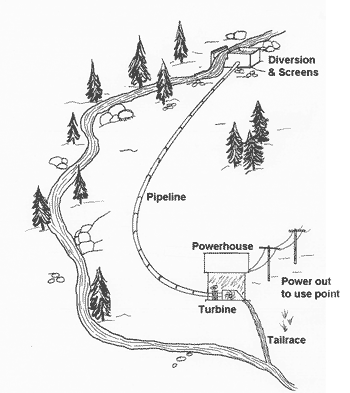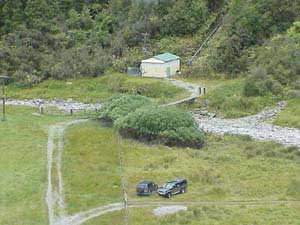

Streaming Hydro or "Run of River?"
Streaming Hydro systems are often referred to as Run of River systems, because the river continues to run rather than being held back by a dam as with Reservoir systems. Although we use the term Streaming Hydro here, Run of River is still a widely accepted term for this type of hydropower system.
" Hydropower extracts energy from water as it flows by.
"Green hydropower continues to generate electricity when the sun goes down and the wind stops blowing. "
Types of Hydropower, continued...
Streaming Hydropower: No Dam, No Lake
Streaming (Run of River) Hydroelectric Projects
 In contrast to Reservoir designs,
Streaming Hydro projects use a completely different approach. First,
there is no dam or reservoir. Instead of a dam, Streaming Hydro
systems use a diversion to channel some of the water from a
stream into a pipe that supplies the water turbine. The rest of the
stream water continues past the diversion down its natural path.
In contrast to Reservoir designs,
Streaming Hydro projects use a completely different approach. First,
there is no dam or reservoir. Instead of a dam, Streaming Hydro
systems use a diversion to channel some of the water from a
stream into a pipe that supplies the water turbine. The rest of the
stream water continues past the diversion down its natural path.
Pictured is a Streaming Hydroelectric powerhouse. A pipeline (not shown) extends from the powerhouse up the hill to a diversion, and directs pressurized water to the turbine inside the building. The water in the foreground has passed through the turbine, and it rejoins the rest of the stream a few feet away.
 How Streaming Hydro Works
How Streaming Hydro Works
The diverted water flows down a pipeline (known as a penstock), passing through a turbine to generate electricity, and then recombining with the original stream. As we discussed earlier, this pipeline is used to contain the water to build high pressure at the bottom where it enters the turbine.
In effect, Streaming Hydro systems “borrow” a portion of the stream’s water to produce power, returning it to the stream after the energy is extracted. Unlike the Reservoir system, Streaming Hydro does not change the natural course of the stream or store water for future use.
This creates a couple of disadvantages. First, without a reservoir there is no reserve capacity for peak load periods. Second, because not all the water from the stream is being used to generate electricity, the output of the hydroelectric system is less than it could be with a Reservoir system.
Streaming Hydro Advantages
But Streaming Hydro has many advantages. First, these systems help resolve the two major disadvantages of the Reservoir system: fish migration and flooding. The stream still flows in parallel with the hydro system, providing an unencumbered path for fish migration. And since there is no reservoir, habitat flooding is not an issue.

Another example of a Streaming Hydroelectric powerhouse. Notice the pipeline feeding into the the rear of the powerhouse.
Because most Streaming Hydro systems are smaller – typically less than 30 megawatts – they occupy very little space and tend to blend into the environment. This makes them ideal for smaller streams and rivers where a Reservoir system wouldn’t be appropriate. A side benefit is that transmission lines are much shorter; in fact, they often reduce transmission losses by providing locally generated power instead of requiring lines from large generating plants that may be hundreds of miles away.
These are important considerations today, as potential sites for large reservoir systems are extremely limited. There are thousands of smaller streams that could be used for Streaming Hydro with minimal visual and environmental impact.

Continue to The Electricity Grid
